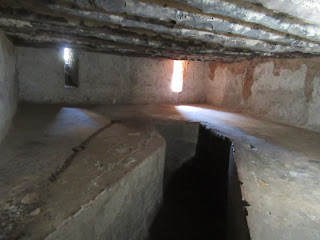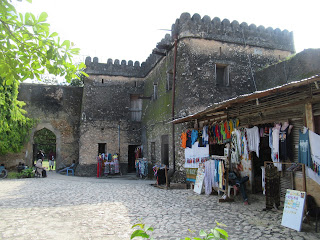A few along the beach to the neighbouring hotel.
After some R&R on the beach, I headed back to Stone Town, the original settlement on the island and found my hotel down a maze of narrow back streets.
And then I went for a walk to see some of the sights of the town such as the central market, built by the British between 1904 - 1906.
It has different sections such as the fish auctioneer where whole catches are sold off.
And the meat section and not for the squeamish.And a view of one of the sides of the market. There is also a spice section and the fruit and veg stalls but there are some many of them that they have spilled out into the surrounding roads and alleys.
The original Missionary Building.
And then the place that was of the greatest interest to me. The former slave market. Slavery here was only finally abolished in he 1870's.
The site now has a cathedral built on it. The east end of the cathedral with a staircase on the outside and a separate door to reach the organ.
The west end of the building.
The entrance,
and the inside.
A general view of the building and under the tree just to the right of the photo...
is the memorial to the slaves that were shipped from here along the coast to work in the plantations and up to Arabia to work as domestic servants. About a quarter were settled on the island to work in the spice plantations for which the area was renowned.
Not o lot of the former slave market exists but two cells form the foundations of a missionary building that became the hospital and is now a hostel. The slaves would lie on the raised area and the sea came in to the channel at high tide to wash away the excrement at high tide.
One of the ornate doors of the old quarter. The arch and the spikes are an Indian influence whereas Arab buildings tend to have no spike ornamentation and straight lintels.
The Catholic cathedral.
And during my walk about I also checked out some of the better hotels such as this former palace of a merchant, now an expensive hotel.
One of the many courtyards.
And one of the rooms.
Lastly I visited the fort built by the Portuguese but later attacked and occupied by Omani forces, and the Spice Islands were the only non European colony in Africa. One of the six towers.
Inside the inner courtyard which now houses a souvenir market for tourists.
Another view of one of the towers.
Sone of the battlements.
And the entrance to the castle which has been extended and now houses the Tourist Information office.
Next door is the former palace of the ruler of the Spice Islands, a grand building but the roof has suffered some damage and it is not open to the public.




























No comments:
Post a Comment